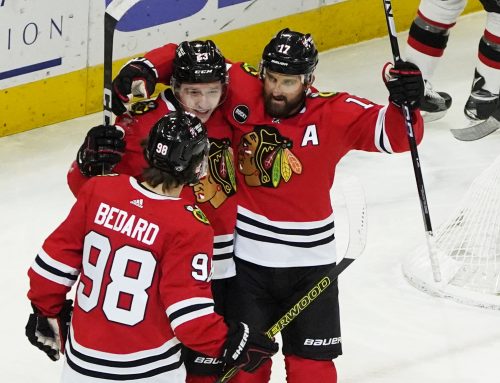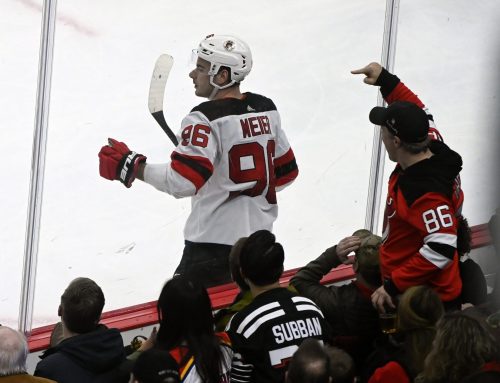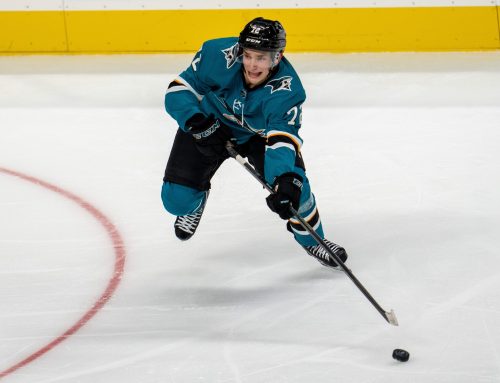Ramblings: Pens/Sharks, Duclair, Las Vegas, Perry/Getzlaf, more (June 2)
Michael Clifford
2016-06-01

Pens/Sharks, Duclair, Las Vegas Expansion, Perry/Getzlaf, and More High-Danger Chances
****
The Stanley Cup Final got an overtime, and it landed in Pittsburgh’s favour by a 2-1 score. It gives the Penguins a 2-0 series lead heading back to San Jose for Saturday.
Game 2 picked up where Game 1 left off, and that was break-neck speed from both sides. Each team found a post in the opening frame, neither converted, but it was still an incredibly entertaining period. Play slowed down as the minutes wore on, but likely because the pace they established just couldn’t maintain. The shots favoured Pittsburgh by five, but either team could have realistically come out of it with a lead.
Phil Kessel gave the Pens a 1-0 lead off a feed from Nick Bonino following a brutal turnover by Roman Polak. The ice really started to tilt in the second overall, as the Sharks really could not generate anything sustainably dangerous in the Pittsburgh zone. I would give credit to the Penguins here; they did a great job with consistently pressuring, and getting the puck out of their zone with control, or at least a fifty-fifty puck.
The depth of the Penguins was the difference in this game for most of regulation. Consider that this was about half-way through the third period…
Sharks with Thornton on the ice tonight: 56.7% Corsi
Sharks without Thornton on the ice tonight: 37.5% Corsi
— Scott McLaughlin (@smclaughlin9) June 2, 2016
All that didn’t matter of course, as Justin Braun tied up the game on a point shot that went off the post and in. It went in with a little over four minutes left in regulation, and we were sent to overtime.
Before we got to OT, this came across my Twitter timeline. It’s just six periods of hockey, but it was a weird thing to see:
Strange but true: PIT is +19 in 5v5 shots w/ Justin Schultz on ice through the first two games. When he's off the ice, they are -9
— Prashanth Iyer (@iyer_prashanth) June 2, 2016
Overtime didn’t last too long, as Conor Sheary grabbed a pass from Letang in the high slot and just rifled one over the glove of Martin Jones.
Sheary OT winner pic.twitter.com/4DfXHlH02H
— Stephanie (@myregularface) June 2, 2016
Not for nothing, but Justin Schultz has at least looked serviceable for the Penguins. All the talent they have helps, but he has been far from the liability I certainly thought he was playing for Edmonton. Might be worth keeping an eye on his landing spot in deeper leagues for fantasy next year…
****
A couple of players that are really going to give some headaches when it comes to rankings next year is the dynamic Ducks duo of Ryan Getzlaf and Corey Perry.
Perry now has two straight seasons of declining goals per game totals, point per game totals, and shots per game totals. Of course, he also has had declining ice time per game in those seasons, but his per minute stats at five-on-five have been declining as well.
Not surprisingly, it’s been a similar drop for Getzlaf as well. Two straight years of declining goals, point, and shot per game totals. The same goes for his per minute stats at five-on-five.
So this isn’t just one down year for Perry and Getzlaf. This is now two in a row. Both guys have turned 31 years old since the season ended, and both guys have roughly 1000 regular season/postseason games under their belts.
I personally haven’t done any projecting into next year beyond looking at last year’s results, but this is concerning. The Ducks fired a pretty good coach and are assuredly going to hire a lesser one. The numbers with Getzlaf and Perry when playing apart, as they did for about half of last year, haven’t typically been very good over the years, either. So will the new coach keep them apart, or bring them back together? That is very much an open-ended question.
Neither are first round picks next year, and Perry is the only one, I think, that might be given second round consideration. It’ll be an interesting summer reading and researching what to do with these two guys in fantasy next year because I’m not sure there’s a good and/or right answer at the moment.
****
The Dobber Prospects Report is now available in the Shop! Get everything you need heading into the draft, and to get to know the NHL’s next wave of talent from a fantasy angle.
****
It’s worth pointing out the players that were able to generate individual high-danger scoring chances (iHSC) last year, taken from War On Ice. They are reasonably good indicators of offensive potential, and can help highlight players that may not have stood out otherwise.
Nichushkin
Valeri Nichushkin hasn’t really lived up to expectations that some – myself included – levied upon him when drafted. He possesses all the physical tools necessary, but to this point, has just 64 points in 166 career games. That includes a 2014-2015 season that was largely missed due to hip surgery.
His 69 iHSC last year was fourth among regular forwards aged 20 or younger, though. It was higher than names like Nathan MacKinnon (63), Dylan Larkin (59), and Anthony Duclair (47). He played fewer five-on-five minutes than the first two, and exceeded Duclair by about 90 minutes (which wouldn’t make up the 22 iHSC difference). He did that without regular line mates as well, as his most common forward line mate was Jason Spezza, with whom Nichushkin played under 50-percent of his ice time.
I don’t think it’s time to give up on the young Russian yet. In fact, he’s the archetypical post-hype sleeper. After failing to really bust out offensively, his draft day price next year should be incredibly low (his ADP was around the 200th pick last year as it was), making him the perfect bench target.
Jenner
Seeing as Jenner had 30 goals last year, it makes sense that he also had a pretty high iHSC number to go with it, as his 85 was second on the Blue Jackets behind Brandon Saad’s 99.
What hurt Jenner’s production last year fantasy-wise was his assist total, as he finished with just 19 on the year. That kept his overall point production under 50, and hopefully is something that will keep his draft day cost depressed for the 2016-2017 season.
The thing about that assist total is that it should rebound. His individual assist percentage (IAP), or the rate at which he assisted on goals that occurred while he was on the ice at five-on-five, was under 30-percent, the worst rate of all Jackets forwards. It caused him to have one fewer five-on-five assist than Matt Calvert.
Assuming his IAP rebounds, and it should, given his iHSC, it looks like Jenner is on the verge of a 60-point season next year. That should only be helped by another assumption, and that is Jenner gets more ice time as well. With his across-the-board production, and hopefully improved defence/goaltending, Jenner could very well be the next David Backes-type player in fantasy.
Rieder
Any guesses as to which Arizona forward led the team in iHSC? Not Max Domi, and not Anthony Duclair. It was, in fact, Tobias Rieder with 75.
There were two reasons Rieder didn’t have a huge offensive season. First, Arizona scored fewer than two goals per 60 minutes at five-on-five (1.92, to be exact) when Rieder played with Antoine Vermette, and that’s a very low number. By contrast, when playing with Martin Hanzal, the Coyotes scored 2.55 goals per 60 minutes. Over the course of a full season, that would be about 10 goals, and maybe 7-8 points for Rieder. Second, he was sixth among Coyotes forwards in power play ice time, and didn’t get a ton of production in those minutes (second-lowest point rate among all Coyotes forwards while on the PP).
Rieder will be going in his third full season, and with all the kids having another year under their belts, and the team hopefully improving overall, there is opportunity for growth here. While he’s not a must-know for next year, there is potential for 20 goals and 45 points, and that’ll play in 14-team leagues as a depth forward.
****
Of course, there won’t be anything confirmed by the NHL until it’s written in blood, but it appears as though the league will be going ahead with an expansion team in Las Vegas, beginning in the 2017-2018 season.
There is a lot that will go into this, specifically from a player’s perspective. The status of no-trade/no-movement clauses is going to be critical in determining which players are protected in an expansion draft (and a distinction between the two will be made by the NHL in this regard, I presume). This will also likely have an impact on trades over the next year or so, given that young players who can be protected because of contract status will have an additional premium placed on their trade value.
I don’t worry too much about talent dilution, either. With the near-extinction of true enforcers, there are a lot of teams running four lines deep with players that actually have NHL-level skills. There are players that teams seemingly have no use for that other teams almost assuredly could (looking at Alex Khokhlachev as a recent example).
Adding a Western Conference team will help bring a bit more balance, and seems to make it inevitable that a 32nd team gets added to the league in short order. Where that 32nd team ends up is another discussion, but Las Vegas should be competitive after a few seasons.
****
One of the hardest things to do when attempting to be successful in fantasy is not only separate fact from fiction, but also tempering the hype.
As far as hype goes, think of Jonathan Drouin. At this moment, just take a wild stab in your head (not at your head) about where Drouin will be drafted in roto leagues next year. Now, think if the Lightning don’t bring him back for the playoffs, where does he get drafted? His ADP was probably cut in half thanks to 17 games, which would amount to about 20-percent of a regular season. After realizing the hype has been cranked up for him, that’s when it’s time to delve into the playoff numbers, and see what was warranted in those 17 games.
I think a similar process needs to be applied here for Anthony Duclair. The Duke shot 19-percent last year, one of three players that played at least 80 games to do so (Adam Henrique and Zack Smith were the others). Alex Tanguay did that two years ago, and saw his goal total fall by 14 (though Tanguay is a proven high-percentage scorer otherwise). We know how shooting percentage regression works.
What concerns me is that Duclair barely shot at all last year, landing 1.3 shots on net per game. If it was something close to 1.8 or 2.0, that wouldn’t concern me nearly as much for a 20-year old rookie. On Arizona alone, Duclair took fewer shots per minute than guys like Boyd Gordon and Antoine Vermette. League-wide, Duclair ranked 248th out of 260 forwards with at least 750 minutes played in shots per minute at five-on-five. His individual high-danger scoring chances weren’t very good, either, as I mentioned earlier in the Rieder section.
Yes, this is all for a rookie, and one that played under 15 minutes a game. I’m just not so sure there’s a natural progression in overall point production next year, and that’s all that matters in fantasy. The hype will be that he and Domi are the up-and-coming dynamic tandem in the NHL. They very well may be, proving me dead wrong on this, but I don’t think Duclair progresses to be a 25-30 goal, 55-60 point player next year, though.
The team shot over 10-percent with him on the ice at five-on-five. A drop is coming in that regard, as well as his personal shooting percentage. I think a couple more minutes of ice time per game will only mitigate these percentage drops, and keep him as a 45-50 point player, rather than improve his raw totals, which is probably where most fantasy owners think he will be heading.
*Stats from Hockey Reference, Hockey Analysis, and War On Ice.
6 Comments
Leave A Comment
You must be logged in to post a comment.





 WSH
WSH NYR
NYR NSH
NSH VAN
VAN COL
COL WPG
WPG L.A
L.A EDM
EDM CHI
CHI T.B
T.B CAR
CAR NYI
NYI

So far both games of the SCF have been fantastic. Saturday’s game will tell us if this is going to turn into a series or not but I still can’t see San Jose beating Pittsburgh 4 out of 5 games to win the Cup even if they win on Saturday.
Micheal.
I have the perception that points are declining for a significant portion of players not just Getzlaf & Perry. I haven’t run any serious research to determine if this is fact except looking at the top 40 scorers or so over the last 10 years & age is certainly becoming a factor for Getzlaf & Perry.
In my fantasy leagues; 8 that I manage, 3 that I participate in, 2 of which have been running for more than 20 years, 1 25, we have seen a significant blending of talent. The Superstars don’t separate themselves as significantly from the pack now & often in any given year don’t even place as high as you would expect a superstar to. Sometimes there are circumstances that might reflect this, new coach, playing through injures, trade, what have you but those are rare.
Where it’s become incredibly noticeable is with good players & average players. The difference now is negligible & with the defensmen even more so. Again I haven’t run any serious research to see why it’s happen but it appears to be somewhat obvious as to what it is. Far more teams are rolling 4 lines today & the balance of ice time is far more fairly distributed than it’s been in the past.
In the last 11 years since the 04-05 lock out here is average goals per game. 3.08, 2.95, 2.78, 2.91, 2.84, 2.79, 2.73, 2.72, 2.74, 2.73 & last season 2.71. Coming out of the lock out the NHL went after clutch & grab hockey hard which saw a significant spike in goal scoring pre lock out. Since we have been declining but are still well above pre lock out totals & the last 5 years have been very stable although overall point production has been declining across the board as the points are being distributed over a far larger body of players relating to teams rolling 4 lines more consistently.
There also is a significant trend now where many teams are running 2 primary power play units where in the past teams had 1 primary & some form of a secondary that saw significantly less time. Was & SJ are now in the minority of the teams that still lean on a primary unit. I assume this relates to the speed of today’s game & trying to keep players fresh but as I haven’t tried to deduce quantitatively just an assumption.
Thoughts from the bench.
There is something to this. I wrote in a Ramblings last year that the overall total production for forwards was declining, but the overall number of points wasn’t changing. Rather, more defencemen were accumulating more points, gobbling up the difference in point drop for forwards. So that is a valid point on your part.
With Perry, just for example, his per minute production has decreased like 40-percent from his career-high, and about 25-percent from 2014-2015 to 2015-2016. So while some drop in production is expected, dropping that much is noteworthy.
Agreed.
For Dobber: Prospect report (looks great) has one mistake, Dobber’s top 25 fwds for upcomming draft has Julien Gauthier ranked twice (9 & 15). Assuming 15 was for Vitali Abramov? (not ranked in Dobber’s top 25). Love the report. Cheers
Thank you – that was it. I has moving players up and down and must of mis-pasted one. This will be corrected in the June 12th update.